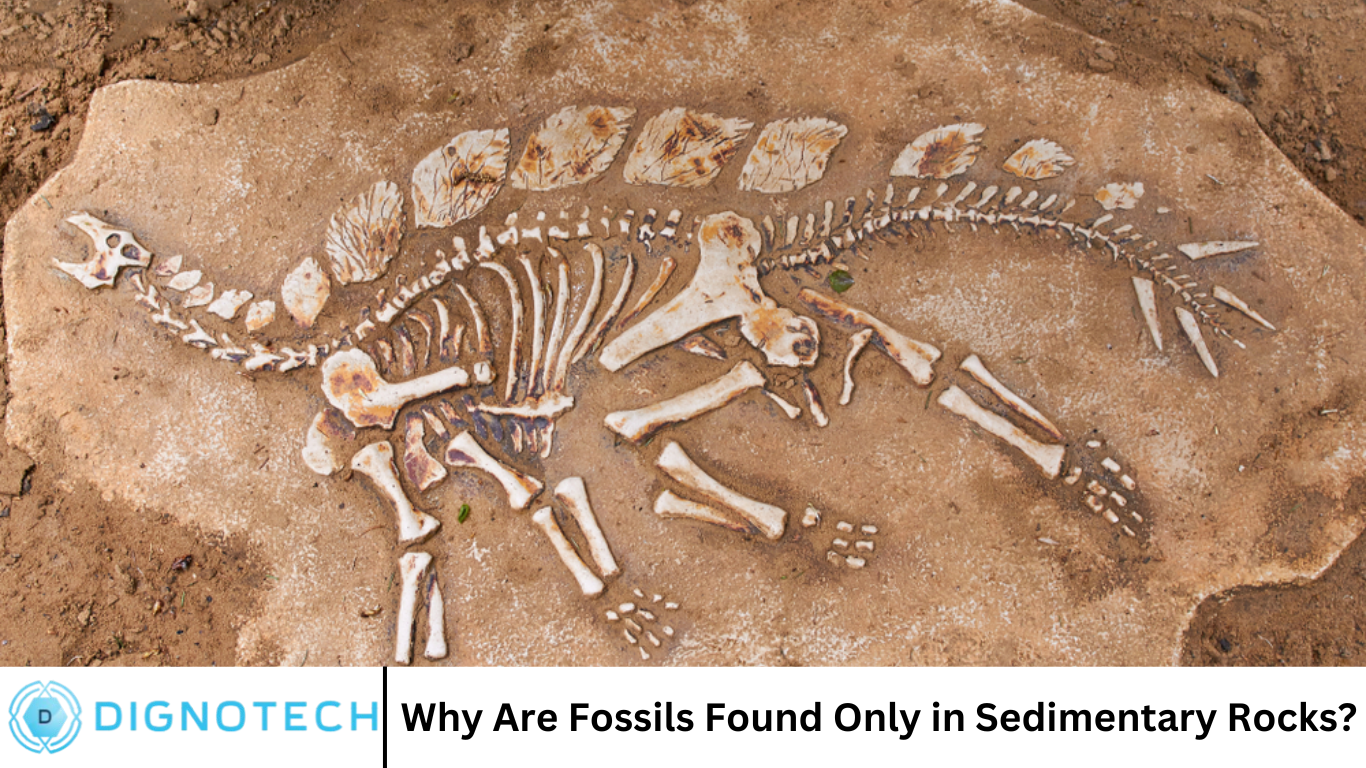Why Are Fossils Found Only in Sedimentary Rocks?

Hi everyone! How are you all doing? Welcome to dignotech.com! Fossils, the preserved remains or traces of ancient organisms, provide invaluable insights into the Earth’s past. They allow scientists, paleontologists, and historians to understand the biodiversity, climate, and geological conditions that existed millions or even billions of years ago. However, fossils are primarily found in one specific type of rock: sedimentary rocks. In this article, we will explore why fossils are found exclusively in sedimentary rocks, the nature of these rocks, and how fossils form. We will also discuss some common questions related to this fascinating topic.
Understanding Rocks and Their Types
Before delving into why fossils are found in sedimentary rocks, it’s essential to understand the three primary types of rocks that make up the Earth’s crust: igneous, metamorphic, and sedimentary rocks.
- Igneous Rocks: These rocks form from the cooling and solidification of molten magma or lava. Igneous rocks are typically hard, crystalline, and lack the ability to preserve organic material because the intense heat during their formation destroys any traces of life.
- Metamorphic Rocks: Metamorphic rocks are formed from the transformation of existing rocks (either igneous, sedimentary, or other metamorphic rocks) under the influence of high pressure, temperature, or chemical processes. While these rocks can sometimes preserve fossils, the extreme heat and pressure conditions often deform or destroy the original organic material.
- Sedimentary Rocks: Sedimentary rocks are formed by the accumulation and compaction of sediments—small particles of rocks, minerals, and organic materials—that settle in layers over time. These sediments can include sand, clay, mud, and even tiny fragments of living organisms. It is within these rocks that fossils are most commonly found, as the conditions are ideal for preserving traces of ancient life.
The Formation of Fossils
Fossilization is a rare and complex process that requires specific conditions for success. The process can take thousands to millions of years, and the chances of an organism being fossilized are relatively slim. For fossilization to occur, the following conditions must be met:
- Rapid Burial: The organism must be quickly buried by sediment to protect it from scavengers, decay, and environmental factors like wind and weather. If burial is too slow or inadequate, the remains may decompose or be destroyed before fossilization can occur.
- Low Oxygen Environment: Fossils form best in environments where oxygen levels are low. Oxygen accelerates decay and the breakdown of organic material. In places like deep oceans or lakes, where oxygen levels are low, the chances of fossilization increase.
- Chemical Conditions: Certain chemical conditions are necessary for the preservation of organic material. Minerals in water or surrounding sediment can replace the organic material over time, turning it into stone and creating a fossil.
- Hard Parts: Organisms with hard parts, such as bones, teeth, and shells, have a higher likelihood of becoming fossils. Soft-bodied creatures, such as jellyfish or worms, are less likely to be preserved, although traces of their existence may still appear as imprints or molds.
Why Are Fossils Found Only in Sedimentary Rocks?
Now that we understand the basic principles of rock formation and fossilization, we can focus on why fossils are almost exclusively found in sedimentary rocks. The unique characteristics of sedimentary rocks make them the perfect environment for fossil preservation.
- Sediment Deposition: Fossils form when organisms are buried by sediments like mud, sand, or clay. Over time, these sediments accumulate and become compacted, turning into solid rock. Sedimentary rocks are created by the gradual deposition of these layers, which can trap and preserve organic materials, including the remains of plants, animals, and microorganisms. As the layers of sediment build up, the pressure causes the materials to cement together, creating a rock that may contain fossilized remains.
- Low Temperature and Pressure: Unlike igneous and metamorphic rocks, sedimentary rocks form under relatively low heat and pressure. This makes them ideal for preserving delicate organic material, which would otherwise be destroyed under the extreme conditions required to form igneous or metamorphic rocks. Fossils can remain largely intact in sedimentary rocks because the conditions do not involve the high temperatures and pressures that would destroy them.
- Layered Structure: One of the most distinguishing features of sedimentary rocks is their layered structure. These layers, or strata, form as sediments are deposited over time. Each layer can represent a distinct period in the Earth’s history, making sedimentary rocks an invaluable record of past environments and ecosystems. Fossils are often found within these layers, with each layer representing a different epoch or age in the history of life on Earth.
- Slow Formation: Sedimentary rocks generally form over long periods, allowing for the gradual accumulation of sediments and organic remains. This slow process provides ample time for the preservation of fossils. In contrast, igneous rocks form relatively quickly from cooling magma, which leaves little opportunity for the preservation of fossils. Similarly, metamorphic rocks, which are created under heat and pressure, can destroy fossils rather than preserve them.
- Water-Based Environments: Many fossils form in water-based environments, such as oceans, rivers, lakes, and swamps. Water is an essential element in the fossilization process, as it helps carry and deposit sediments. Sedimentary rocks, particularly those formed in aquatic environments, are more likely to contain fossils because water plays a crucial role in the deposition of sediments that encase organisms.
- Erosion and Exposure: Over time, sedimentary rocks are subject to erosion and weathering, which can expose fossils at the Earth’s surface. Fossils found in sedimentary rocks are often uncovered by natural processes like wind, water, or ice, which break down and erode the rock layers. As these layers are worn away, fossils may be revealed, offering us a glimpse into ancient ecosystems.
The Role of Fossils in Sedimentary Rock Stratigraphy
Stratigraphy is the study of rock layers (strata) and their sequence in time. Fossils play an essential role in the field of stratigraphy, as they help scientists determine the relative ages of sedimentary rock layers. By analyzing the types of fossils found in different layers, scientists can reconstruct the history of life on Earth and understand the environmental changes that occurred over time.
In particular, index fossils are used to help date rock layers. These are fossils from species that lived for a relatively short period but had a wide geographical distribution. Because they are found in multiple locations and are easily identifiable, index fossils allow paleontologists to correlate rock layers from different regions and build a timeline of Earth’s history.
Frequently Asked Question
Why don’t fossils form in igneous or metamorphic rocks?
Fossils typically do not form in igneous or metamorphic rocks because the heat and pressure required to form these rocks destroy organic material. Fossilization requires specific conditions, such as low heat, low pressure, and rapid burial, which are more commonly found in sedimentary environments.
Can fossils form in volcanic rocks?
While it’s rare, some fossils can form in volcanic rocks. For example, a volcanic ash flow can quickly bury organisms and preserve them in a form of rapid fossilization. However, most fossils are found in sedimentary rocks, where the conditions for fossilization are more ideal.
Can fossils be found in all types of sedimentary rocks?
Fossils are most commonly found in certain types of sedimentary rocks, such as limestone, shale, and sandstone. Rocks that form in water environments, like oceans or lakes, are more likely to preserve fossils. Rocks formed in arid or desert conditions are less likely to contain fossils because the organisms do not get buried as quickly.
How do paleontologists identify fossils in rocks?
Paleontologists identify fossils by examining the structure, shape, and composition of the specimens. Fossils are often studied using various tools, including microscopes, and may be compared with known species in fossil databases.
Why are some fossils found in more than one location?
Fossils can be found in multiple locations if the species had a wide distribution during its time. Sedimentary rocks can extend over vast regions, and fossils can be transported by water or wind to different places before being preserved in new layers.
How old are the oldest fossils found in sedimentary rocks?
The oldest fossils discovered are around 3.5 billion years old. These fossils consist of microorganisms that lived in the Earth’s oceans. Fossils from later periods, such as the age of dinosaurs, are much younger, typically ranging from 250 million to 65 million years ago.
Can fossils be found in ice or amber?
While not a type of rock, fossils can also be preserved in other materials like ice or amber. These methods of preservation occur under very specific conditions, such as when an organism is quickly trapped and preserved in frozen environments or tree sap that hardens into amber.
Conclusion
Fossils are invaluable records of life from Earth’s distant past, and sedimentary rocks are the ideal environments for their preservation. The processes of rapid burial, low temperature and pressure, and the accumulation of sediments in water-based environments all contribute to the ideal conditions for fossilization. While fossils can sometimes be found in other materials like ice or amber, the majority are discovered in sedimentary rocks, which provide a detailed and layered history of life on our planet. Understanding why fossils are found in sedimentary rocks deepens our appreciation for both the Earth’s geological history and the incredible process that leads to the preservation of life for millions of years.





